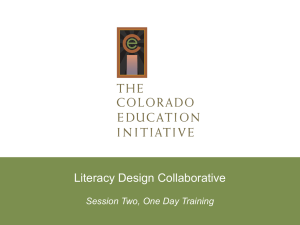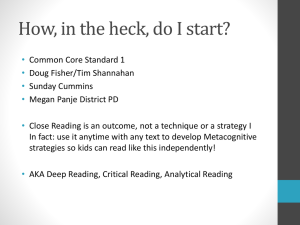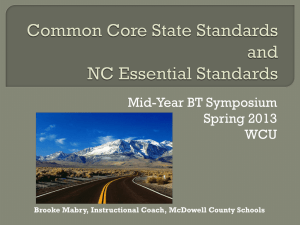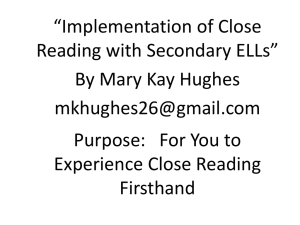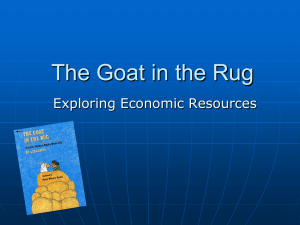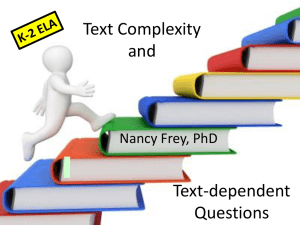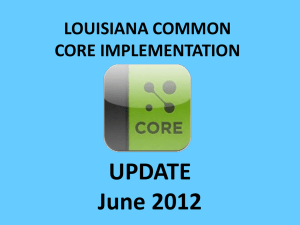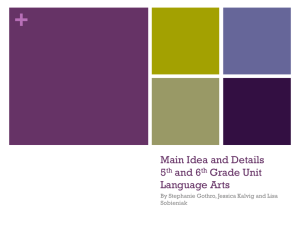Day 1 & 2 PowerPoint - Colorado Education Initiative The Colorado
advertisement
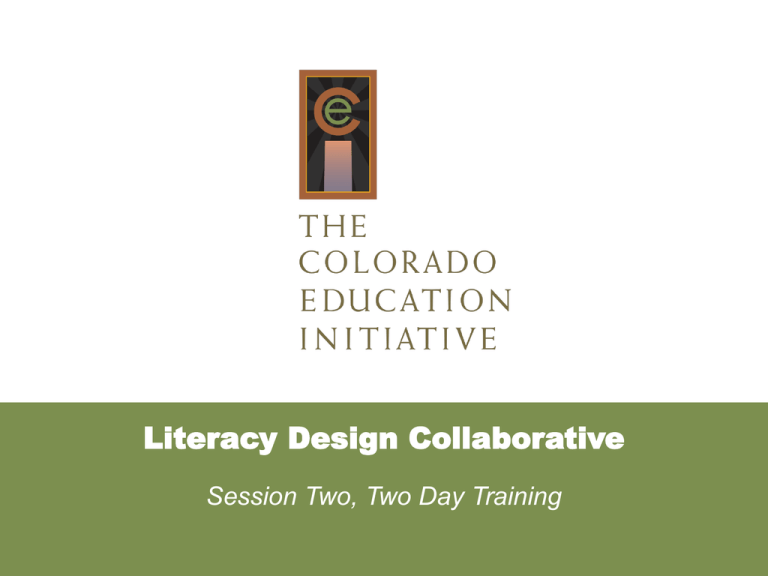
Literacy Design Collaborative Session Two, Two Day Training WELCOME TO THE COLORADO LITERACY DESIGN COLLABORATIVE Session Two, Two Day Training Sharing Successes & Challenges • In your table group, select a recorder and reporter • Make a T-Chart of Successes and Challenges • Be prepared to report out LDC and PARCC • Colorado has decided to be a PARCC state • PARCC will assess student achievement of the Common Core • LDC will help students learn the literacy skills required by the Common Core The PARCC Assessments • Read the released sample item from the PARCC Assessment • Review of each section – what did you notice? • In pairs, discuss the three guiding questions at the back of the handout • Be prepared to report out from pairs to whole group Other Examples • Examples of what assessments might look like in ELA and other content areas can be found at: www.corestandards.org/assets/Appendix_B.pdf Deconstructing the LDC Rubric Form groups of 4 • Identify who is going to “teach” each chunk of scoring elements For your scoring element(s) • Identify vocabulary that will need direct instruction to support student comprehension • Identify the key differences between each rating level (1-4) Share your analysis with your other group members Deconstruction Worksheet • Use the worksheet, “Literacy Design Collaborative Rubric Deconstruction Worksheet • Follow the instructions, paraphrasing each of the elements as you would explain them to your students LDC and PARCC Rubric Comparison • Read the draft PARCC rubric • How do the LDC rubrics compare with the PARCC rubric? • How are they alike? • How are they different? • Share your comparison with a partner Practice Scoring Student Work Samples • Form groups of 4 • Pick one of the student work samples to score • Use the Anchor Paper Annotation Form to record your notes as you determine the score for each element • Once you are done, raise your hand to get the “official scoring” for your paper • Discuss any differences Scoring Student Work from First Modules • Insights from our Teacher Trainers • Score student work in trios Reflecting on Practice • What do I need to consider changing or revising when writing my second module? • What am I going to change in my instructional practice based on what I have learned? (Relate to Educator Effectiveness) • Do a quick-write of your answers to these questions and any reflections or questions you have Review of Example Module • Look at the Teaching Task Section: Overview, Student Background, Task, and Text Selection • Look at the Skills Section: Notice the Grade Level Expectations • Look at the mini-tasks Review of the Module • Using the Module Review Sheet, review 3 Modes of Academic Writing and write one or two comments in each category • Share with a partner when finished • Identify three things you would do differently in your module Beginning Your Second Module: Teaching Task • Select a curriculum focus for second semester where you will use your module • Write your Teaching Task for this module • Have the consultant or one of the Teacher Trainers review your task Text Selection Ask yourself….Will the texts and/or multimedia I’ve chosen provide the students with the information they need to completely respond to the prompt? Check…. the ‘do-ability’ of the task by using the readings to complete the task yourself Choose Texts and Multi-Media •Text selection is critical! •Look for the perfect balance: • reading level of students • complexity of text (demands on skills and stamina of reader) • background knowledge required for comprehension • sufficiency of content for writing task •Keep “Gradual Release” in mind: • whole group • small group • independent •Be sure text provides students with information needed to respond completely to the teaching task Special Note If you are constructing an argumentation task, be sure the quantity and content of texts are not biased. The Dimensions of Text Complexity Why Text Complexity Matters ACT Reading Between the Lines, 2006 Change in text complexity in textbooks over the last century Source: Metametrics Text Complexity It is critical that all students develop the skill, concentration, and stamina to read complex texts for success in college and the workplace. CCSS emphasizes regular practice with complex text and academic language. Why Practice with Complex Text? • Gap exists between college and high school texts • Reading complex text is a predictor for success in college and the workplace • Reading levels of students and adults has declined (50 % graduates proficient) • CCSS challenge teachers to provide scaffolded instruction for every learner and to use complex text Features of Complex Text Structure • Simple/Complex • Conventional/Unconventional • Subtle and/or frequent transitions • Length of paragraphs or mixed structures Language • Literal/Figurative • Contemporary/Archaic • Vocabulary load Features of Complex Text Knowledge Demands (cultural/literary) • Simple/complex themes • Single/multiple themes • Experiences and perspectives same or different from one’s own Knowledge Demands (content/discipline) • Familiar/specific discipline • Low interference to high intertextuality (many references to citations of other texts) Scaffolding Complex Text Support Student Learning to Meet Standard 10 Students read complex text at each grade level independently • • • • Multiple readings Read Aloud Chunking text Provide support while reading What strategies do you currently use that support students using more complex or difficult text? Exit Ticket 1. I used to think_____________________________ 2. Now, I think_______________________________ 3. One idea I learned about LDC today was________ 4. One question I have is_______________________ 5. I want to learn more about____________________ Day 2 • Review of Agenda • Summary of Feedback Reminder of LDC Module Skills and Instruction Guided by Grade Level Expectations from CCSS • The Skills section needs to be refined to reflect the grade-level expectations of the selected skills • An exemplary mini-task needs to reflect the grade-level expectations for the skill being taught Finding the Connection • Look at grade-level standards 7.1, 7.2, and 7.4 on p. 5 of 3 Academic Modes of Writing • How are these standards addressed in the Reading Skills Cluster on p. 7? • Which mini-tasks teach these skills? (pp. 10-12) • Discuss in pairs Individual Exploration of the CCSS Grade Level Expectations • Select the appropriate grade-level handout • Select one reading and one writing grade level expectation that you are most comfortable teaching • Select one reading and one writing grade level expectation that you are least comfortable teaching • Connections: Connect with two people, one at a time, and share your answers (5 minutes per round) The Teaching Task • Revise if needed • Complete all sections of the Teaching Task tab in Module Creator • Use the learning from the review of the Exemplar Module Advice from Teacher Trainers • Lessons Learned Top Ten: Do NOT • Do all of the built-in mini-tasks in one module; mini-tasks are selected based on skills to be taught. You can also add them if needed. • Underestimate what your kids are capable of doing • Select all digital texts • Think of a module as necessarily a whole unit • Make assumptions about what kids have learned about writing in English class More Do NOTs • Cut the time too short • Stress-out…this is a pilot • Work in isolation • Make a module huge, check every standard and select 15,000 resources • Underestimate the power of making mistakes Top Ten: To DOs • Talk to other teachers: collaborate and create crossdisciplinary modules • Give intentional directions for developing parts of the writing process • Incorporate lab experiences and authentic writing to hook students • Share and clone modules with colleagues • Make the module your own More To DOs • Remember that mini-tasks are the most important part of the modules • Use media, not only texts for resources • Incorporate Socratic Seminars • Add lessons you love into your module mini-tasks • Go for depth, not broad coverage of material Completing Your Module • Will do this section by section • Teacher Trainers will help vet a section before you move on • Remember: Focus on Grade Level Expectations! Resources for Module Development Skills Selection • Use Module Creator to select your skills • Add at least ONE grade-level expectation to each skill in the reading cluster and ONE to each in the writing cluster • Eventually all skills should be refined to be grade-level specific • Have your skills section vetted Constructing Mini-Tasks • Text-Dependent Questions • Close Reading Tools for Teachers Close Reading & Text-Dependent Questions Implementing Key Shifts in the CCSS—Part Two Key Shifts in the Standards Reading Complex Texts In-Depth Students can build knowledge through close reading of materials facilitated by text-dependent questions that require evidence drawn from what they have read. “Close Reading” and Anchor Reading Standards The CCSS Anchor Reading Standards: • Prioritize the “close reading” skills of extracting evidence and making inferences (Standard 1) when reading complex text (Standard 10) • Frame the performance of the intervening Anchor Standards 2-9 as relying on the central “close reading” skill of citing specific textual evidence from complex text • Create a ladder that students must climb to demonstrate college and career readiness Why focus on “close reading”? “One of the key requirements of the Common Core State Standards for Reading is that all students… must be able to read and comprehend independently and proficiently the kinds of complex texts commonly found in college and careers.” --CCSS Appendix A, pg. 2 In the context of an “effective, comprehensive reading program designed to develop proficient readers with the capacity to comprehend texts across a range of types and disciplines (CCSS ELA & Literacy, pg. 15),” “close reading” instruction facilitated by a skilled teacher is one of many research-based strategies that can help students become independent and proficient readers of increasingly complex texts. Why Depth Through “Close Reading” Matters Close reading instruction: • Motivates students by rewarding them for reading inquisitively • Requires careful attention to how the text unfolds through asking text-dependent questions • Focuses on building knowledge through the strategic use of textdependent questions • Can prepare students for the kinds of reading tasks they will encounter after graduation Time to Reflect Educators must become deeply familiar with “close reading” as readers in order to design and deliver effective “close reading” instruction. Encouraging Close Reading One strategy for encouraging Close Reading is the use of Text-Dependent Questions. Writing Text Dependent Questions What are Text-Dependent Questions? • Draw the reader back to the text to discover what it says • Have concrete and explicit answers rooted in the text • Frame inquiries in ways that do not rely on a mix of personal opinion, background information, and imaginative speculation Creating Text-Dependent Questions • An effective text dependent question delves into a text to guide students in extracting the key meanings or ideas and events found there • To achieve this end, text dependent questions begin by exploring specific words, details, explanations and arguments • They then investigate the text by utilizing the Anchor and/or Grade-level Reading Standards to generate the question Review and Revise • Read the Handout, Text-Dependent Questions and the CCSS • Revise your questions as needed to be effective textdependent questions Tools for Creating Text-Dependent Questions: Text-Dependent Question Worksheet A systematic approach to creating textdependent questions for complex texts while aligning them with the demands of the CCSS. USING TEXT DEPENDENT QUESTIONS TO SUPPORT CLOSE READING Creating Text-Dependent Questions for Informational Text From Martin Luther King’s note to “Letter from Birmingham Jail”: Begun on the margins of the newspaper in which the statement appeared while I was in jail, the letter was continued on scraps of writing paper supplied by a friendly Negro trusty, and concluded on a pad my attorneys were eventually permitted to leave me. Creating Text-Dependent Questions for Informational Text From Martin Luther King’s note to “Letter from Birmingham Jail”: Begun on the margins of the newspaper in which the statement appeared while I was in jail, the letter was continued on scraps of writing paper supplied by a friendly Negro trusty, and concluded on a pad my attorneys were eventually permitted to leave me. Creating Text-Dependent Questions for Informational Text From Martin Luther King’s note to “Letter from Birmingham Jail”: Begun on the margins of the newspaper in which the statement appeared while I was in jail, the letter was continued on scraps of writing paper supplied by a friendly Negro trusty, and concluded on a pad my attorneys were eventually permitted to leave me. Creating Text-Dependent Questions for Informational Text From Martin Luther King’s note to “Letter from Birmingham Jail”: Begun on the margins of the newspaper in which the statement appeared while I was in jail, the letter was continued on scraps of writing paper supplied by a friendly Negro trusty, and concluded on a pad my attorneys were eventually permitted to leave me. Work on Mini-Tasks • Begin designing mini-tasks for your selected skills • Make sure at least one mini-task for reading and one for writing reflect grade-level expectations • Have vetted In Closing • Instructions for next session • Available Support (PDS Units) • Debrief • Evaluation Participant Expectations • Finish and implement second module • Collect student work to use in Session III • Focus on grade-level expectations for CCSS Literacy Standards • Teach reading and writing skills directly through the minitasks Add contact information for LDC trainer
